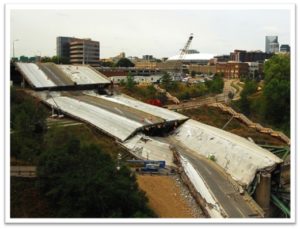Normally, every five or six years our elected representatives in D.C. put aside their political differences to reauthorize the nation’s transportation program — including the fuel tax, for construction of roads, bridges, transit and bike and pedestrian infrastructure, and safety programs.
This is because our economy relies on transportation, and bridges and highways are not Republican or Democrat. Everybody needs them.
The process has broken down
On March 30, Congress managed to avoid a shutdown of the nation’s transportation system by passing an eleventh hour extension of the current SAFETEA-LU legislation. This means that thousands of highway and infrastructure projects, here and across the nation, won’t stall out this construction season. Until June 30th, anyway.
Funding our transportation infrastructure via nine “temporary” extensions – one stopgap measure after another, since the original SAFETEA-LU expired in September 2009- is not the way to move forward. The process has broken down.
The reason is simple: money
The major problem is the growing inadequacy of the federal gas tax, which hasn’t been raised since 1993. Not only are we attempting to build 21st-century infrastructure with 20th-century dollars, but also, as cars become more efficient, people need less fuel and pay less into the Highway Trust Fund.
With Congress bitterly divided, lawmakers can’t agree on where the additional funding should come from, although a number of ideas are being floated.
Legislative stalemate
For the past several months, the House attempted to gain enough support to pass a 5-year, $260 billion bill (the American Energy and Infrastructure Jobs Act) that has new revenue incorporated into it via leasing and production fees from new oil-drilling rights on federal lands and coastal waters. This funding mechanism, although favored by nearly two-thirds of Americans (according to a poll by the United Technologies/National Journal Congressional Connection), failed to gain bipartisan support.
Another provision of the bill, which would have terminated guaranteed funding for public transit, failed to gain even Republican support in the House and as a result, the bill was doomed from the start.
The Senate alternative (MAP-21), a two-year program with a price tag of $109 billion — had bipartisan support but was not taken up by the House and is unlikely to move forward even though the clock is again ticking.
Reforms to control spending
And before asking taxpayers to pay more for roads, rail, bridges, and infrastructure, we must ensure existing funds are not wasted. Both bills include significant reforms to control federal highway spending.
Both of the Senate and House bills include provisions to make the project delivery process more efficient and both consolidate existing transportation programs by nearly two-thirds.
And many lawmakers rightly argue that states should be given more flexibility in how they can find creative ways to use federal dollars. Congress should give more encouragement to innovative approaches, including public-private partnerships that leverage private investment with public dollars.
Gas taxes or user fees are not on the table – but need to be
In the current political climate, no one in Washington is going to suggest an increase in the gas tax. Yet more revenue from that source – or from a mileage-based user fee – is an essential part of a solution.
Every transportation policymaker understands the potential long-term solutions to these near-term problems, but few are willing to push them forward because they involve difficult choices about how to raise more money for federal transportation programs.
Election-year politics
“We’ve just been caught up partially in election-year politics and partially in this whole battle that seems to trump and override our issue, which is the budget battle,” said Pete Ruane, president and CEO of the American Road & Transportation Builders Association. “That’s going to be part of this debate every single time until they finally make some tough decisions about how to fund these programs.”
Congress has now bought itself until just before the July 4 recess to come up with a final agreement on a transportation bill — or enact another extension.
Hopefully, over the next 90 days Congress will work something out and maybe by the end of the year we’ll have a long-term bill. But it’s also likely the issue won’t be settled until after the general election in November.
Everyone agrees on the broader goals of transportation policy and spending, which are economic growth and personal mobility. A long-term solution needs to be developed in a bipartisan fashion — and spearheaded by the administration — regardless of who is in power.
Co-writing credit: Rondi Watson








